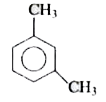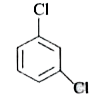Which branched chain isomer of the hydrocarbon with molecular mass 72u gives only one isomer of mono substituted alkyl halide ?
Tertiary butyl chloride
Neopentane
Isohexane
Neohexane
The correct Answer is:B
To solve the problem, we need to identify the branched-chain isomer of a hydrocarbon with a molecular mass of 72 u that gives only one isomer of mono-substituted alkyl halide. Let's break it down step by step.
Step 1: Identify Hydrocarbons with Molecular Mass of 72 u
The molecular formula of hydrocarbons can be represented as C_nH_m. The molecular mass can be calculated using the formula:
Molecular Mass=12n+m
where n is the number of carbon atoms and m is the number of hydrogen atoms.
To achieve a molecular mass of 72 u, we can start by testing different combinations of n and m.
Step 2: Calculate Possible Combinations
1. If n=5:
12(5)+m=72⟹60+m=72⟹m=12
This corresponds to pentane (C5H12).
2. If n=6:
12(6)+m=72⟹72+m=72⟹m=0
This corresponds to hexane (C6H0), which is not valid.
3. If n=4:
12(4)+m=72⟹48+m=72⟹m=24
This is not possible since hydrocarbons cannot have more than 2 hydrogen atoms per carbon in a saturated compound.
Step 3: Identify Branched Isomers
Among the valid hydrocarbons, we can check for branched isomers of pentane (C5H12):
- n-pentane (straight chain)
- isopentane (branched)
The molecular mass of both isomers is 72 u, but we need to check which one gives only one isomer of mono-substituted alkyl halide.
Step 4: Analyze Substitution Reactions
1. n-Pentane:
- Substitution can occur at any of the 5 hydrogen atoms, leading to multiple isomers (e.g., 1-chloropentane, 2-chloropentane, etc.).
2. Isopentane (or 2-methylbutane):
- All hydrogen atoms on the methyl groups are equivalent, leading to only one possible product when chlorinated (e.g., 2-chloro-2-methylbutane).
Conclusion
The branched-chain isomer of the hydrocarbon with a molecular mass of 72 u that gives only one isomer of mono-substituted alkyl halide is isopentane (2-methylbutane).
Final Answer
The answer is neopentane (C5H12).
The molecular formula of hydrocarbons can be represented as C_nH_m. The molecular mass can be calculated using the formula:
Molecular Mass=12n+m
where n is the number of carbon atoms and m is the number of hydrogen atoms.
1. If n=5:
12(5)+m=72⟹60+m=72⟹m=12
This corresponds to pentane (C5H12).
12(6)+m=72⟹72+m=72⟹m=0
This corresponds to hexane (C6H0), which is not valid.
12(4)+m=72⟹48+m=72⟹m=24
This is not possible since hydrocarbons cannot have more than 2 hydrogen atoms per carbon in a saturated compound.
Among the valid hydrocarbons, we can check for branched isomers of pentane (C5H12):
- n-pentane (straight chain)
- isopentane (branched)
1. n-Pentane:
- Substitution can occur at any of the 5 hydrogen atoms, leading to multiple isomers (e.g., 1-chloropentane, 2-chloropentane, etc.).
- All hydrogen atoms on the methyl groups are equivalent, leading to only one possible product when chlorinated (e.g., 2-chloro-2-methylbutane).
The branched-chain isomer of the hydrocarbon with a molecular mass of 72 u that gives only one isomer of mono-substituted alkyl halide is isopentane (2-methylbutane).
The answer is neopentane (C5H12).
Topper's Solved these Questions
Similar Questions
An organic compound A(C4H6CI) on reation withNa/diethyl ether gives a hydrocarbon which on monochlorination gives only one chloro derivative A is .
View SolutionGive the name and structure of the lowest molecular mass cumulative polyene that shows only geometrical isomeris ( diastereomers ) and not optical isomers.
View Solution
Knowledge Check
Which one of the following compounds give only one isomer upon nitration ?
A B
B C
C D
D
Which of the following substituted benzene derivatives would furnish isomer when one more substituent is introduced ?
A B
B C
C D
D
An organic compound of molecular formula C4H10O does not react with sodium. With excess of HI, it gives only one type of alkyl halide. The compound is
AC2H5IOC2H5BCH3C∣OCH3HCH3CCH3CH2CH2OCH2DCH3CH2CH2OH
An organic compound A(C4H9Cl) on the reaction with Na/diethly ether gives a hydrocarbon which on monochlorination gives only one chloro derivative then, A is
View SolutionWhich of the following isomer having molecular formula C6H14 will give minimum number of mono-chloro derivatives?
View SolutionThe compound with molecular formula C8H10 which will give only two isomers on electrophilic substitution with Cl2/FeCl3 or with HNO3/H2SO4 is
View Solution(A), (B) and (C ) are three non-cylic funtional isomers of a carbonyl compound with molecular formula C4H8O. Isomers (A) and (C ) give positive Tollen's test whereas isomer (B) does not give Tollens' test but gives positive iodoform test. Isomers (A) and (B) on reduction with Zn(Mg) | conc. HCl give the same product (D).
(a) Write the structures of (A), (B) ,(C) and (D).
(b) Out of (A), (B) and (C ) isomers, which one is least reactive towards addition of HCN ?
View SolutionPhenyl subsituted hydrocarbon (A) molecular mass 120 on monobromination can give 3 isomeric products only Major product (B) on treatment with sodium gives (C). Find (A) (B) and (C)
View Solution
